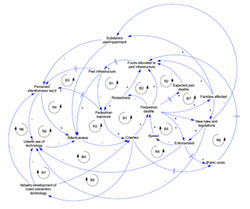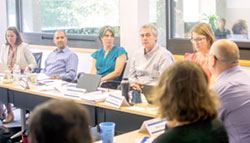What is Systems Science?
A set of tools and methods for studying complex systems, or systems whose properties cannot be fully explained by understanding individual components. Complex systems are made up of many interacting elements and, through these interactions, can produce persistent and adaptable trends that can be hard to predict and alter. There are several examples of complex systems underlying challenging transportation safety issues (e.g., interacting social, political, environmental factors underlying substance-involved crashes). Systems science offers a range of tools and methods to help appreciate and explore this complexity, and with that, help better inform transportation safety decision-making.
Benefits of Applying Systems Science to Road Safety Research and Practice
1. Harness tools to improve understanding of complex problems
Systems science offers formal tools, both qualitative and quantitative, to help recognize and understand the complexity of persistent challenges as well as to identify solutions. These tools can help facilitate collaborative problem-solving and orient new partners to a shared vision, such as reducing transportation injury and death.
2. Explore systems assumptions and interactions
Causal loop diagrams are one systems science tool that can help with understanding relationships between system elements.

Systems science fosters thinking about the underlying structures of systems that are driving problems, and offers ways to explore assumptions and interactions between system elements. In the transportation context, this approach can help shape a more refined approach by prompting thinking about the underlying transportation system structures that lead to traffic fatalities, surfacing assumptions and values, and clarifying the relationships between the components of the system and how they can or should interact.
3. Provide a framework for considering policies and engaging stakeholders
Multidisciplinary stakeholder input and engagement can be supported by system science approaches for modifying systems, policies, and practices for a safe road system

System science approaches can help develop shared approaches for policy and intervention, using effective tools to foster multidisciplinary engagement. They can support strategic planning by offering insights into how to leverage a system’s behavior to maximize policy impact and/or sustainability, enrich policy discussions, offer ways to examine the unintended consequences of policies and practices, and simulate the synergistic effects of different scenarios. Systems science methods can also be used to improve public engagement through group consensus building and systems modeling as a communication tool. This can promote agency coordination to get buy-in from all jurisdictions responsible for the safety of the system.
CSCRS Contributions
Several specific CSCRS projects provide examples of integrating systems science into transportation safety research to examine underlying complexity with the goal of better informing practice. A few example projects include R1: Structures of stakeholder relationships in making road safety decisions, R17: Strengthening existing and facilitating new Vision Zero plans, R21: A systems approach to pedestrian safety, Phase II: Examining congestion pricing policies and RR1: Explaining the rise in pedestrian fatalities: A Safe Systems approach.
Additional Resources
Example Applications
- Macmillan A, Connor J, Witten K, et al. The societal costs and benefits of commuter bicycling: simulating the effects of specific policies using system dynamics modeling. Environ Health Perspect. 2014; 122(4): 335-44. doi: 10.1289/ehp.1307250.
- Zulauf CA, Schneider F. Systems Thinking at BMW: Clearing Up Germany’s Traffic Jam. https://thesystemsthinker.com/systems-thinking-at-bmw-clearing-up-germanys-traffic-jam/
- Goh YM, Love PED. Methodological application of system dynamics for evaluating traffic safety policy. Saf Sci. 2012; 50(7):1594-1605. doi: 10.1016/j.ssci.2012.03.002.
- McClure RJ, et al. Simulating the Dynamic Effect of Land Use and Transport Policies on the Health of Populations. Am J Public Health. 2015; 105(52): S223-S229. Doi: 10.2105/ajph.2014.302303.
Tools to get started
- Hovmand, Peter S., Etiënne A. J. A. Rouwette, David F. Andersen, and George. P. Richardson. 2015. Scriptapedia. https://en.wikibooks.org/wiki/Scriptapedia
- Los Gatos, CA; 2019. https://kumu.io/
- Mental Modeler. 2019. http://www.mentalmodeler.org/
Key Foundational References
- Meadows DH. Thinking in systems : a primer. London; Sterling, VA : Earthscan, 2009.
- Sterman J. Learning from evidence in a complex world. Am J Public Health. 2006; 96(3): 505-514. doi: 10.2105/ajph.2005.066043.
- Sterman J. Business dynamics. New York, NY: McGraw-Hill, Inc.; 2000.
- Luke DA, Stamatakis KA. Systems science methods in public health: dynamics, networks, and agents. Annu Rev Public Health. 2012; 33:357-376.





